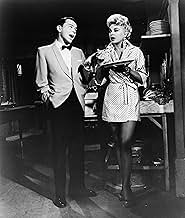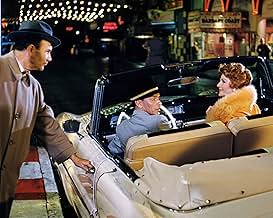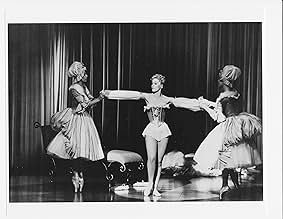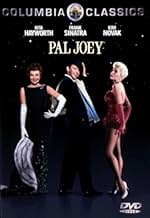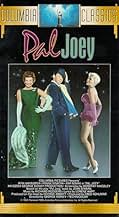CALIFICACIÓN DE IMDb
6.6/10
6.1 k
TU CALIFICACIÓN
Joey Evans es un cantante de cabaret, muy mujeriego, que al llegar a San Francisco encuentra trabajo en un club nocturno. Pronto empieza a flirtear con una viuda adinerada, mientras una jove... Leer todoJoey Evans es un cantante de cabaret, muy mujeriego, que al llegar a San Francisco encuentra trabajo en un club nocturno. Pronto empieza a flirtear con una viuda adinerada, mientras una joven corista se enamora de él.Joey Evans es un cantante de cabaret, muy mujeriego, que al llegar a San Francisco encuentra trabajo en un club nocturno. Pronto empieza a flirtear con una viuda adinerada, mientras una joven corista se enamora de él.
- Dirección
- Guionistas
- Elenco
- Nominado a 4 premios Óscar
- 3 premios ganados y 7 nominaciones en total
Franklyn Farnum
- Guest at Charity Ball
- (escenas eliminadas)
Bess Flowers
- Guest at Charity Ball
- (escenas eliminadas)
Pierre Watkin
- Mr. Forsythe
- (escenas eliminadas)
John Alban
- Guest at Charity Ball
- (sin créditos)
Leon Alton
- Printer Salesman
- (sin créditos)
Isabel Analla
- Undetermined Secondary Role
- (sin créditos)
Robert Anderson
- Policeman
- (sin créditos)
Monya Andre
- Guest at Charity Ball
- (sin créditos)
Maurice Argent
- Second Tailor
- (sin créditos)
Al Bain
- Club Patron
- (sin créditos)
- Dirección
- Guionistas
- Todo el elenco y el equipo
- Producción, taquilla y más en IMDbPro
Opiniones destacadas
Thank god this film is on DVD!It is now possible to skim right through Frank's obnoxious role and concentrate strictly on the two female stars.Talk about a fantasy-the two most beautiful women in the world are obsessed with this obnoxious little man! Kim and Rita are so stunning it is almost surreal. On second glance, Hayworth is still gorgeous here, even though in declining health(alcoholism, etc.). Her skins looks absolutely translucent. The stunning beauty of Rita and Kim and the wonderful Rodgers and Hart songs are the highlights of this entertaining, beautifully photographed musical drama. Barbara Nichols is memorably funny in a tiny role. (TRIVIA: Beautiful dancer/actress Doreen Woodbury committed suicide while in rehearsals for this film).KIm's voice, by Trudi Erwin, on My funny Valentine, sounds exactly how she would sound if she sang! A vocal dead ringer!
I like Sinatra as much as the next girl and then some. Probably the best thing about this film is the numbers The Chairman does alone onstage. However, I'm also well acquainted with PAL JOEY in its stage form, and this watered down film doesn't serve it well. As is so often the case with film musicals, it bears very little resemblance to the show it purports to represent.
First of all, like many other movie musicals this one is rife with interpolations. Viewers should realize that both "My Funny Valentine" and "The Lady is a Tramp" come from Rodgers and Hart's BABES IN ARMS (though, ironically, both were cut from the film version of that musical). "There's a Small Hotel" is from ON YOUR TOES and TOO MANY GIRLS gave us the haunting "I Didn't Know What Time It Was" (probably the interpolation that works best). Secondly, most of the songs they did keep don't remain intact. For instance, when they moved the setting from Chicago to San Francisco the song the club girls sing went to pot. Also, the lyrics to "Bewitched" had to be sanitized for popular consumption, which is a pity because they're some of Larry Hart's best. "Zip" was also revised and given to Vera. The witty "Take Him" was cut, which is a real pity, and several other numbers are gone entirely or reduced to underscoring.
PAL JOEY was one of the first shows to bring cynicism to the musical stage. The second you inject romance into it, you've killed what it's about. If I was just looking for a lightweight love story, I might enjoy this film. Knowing what I know now, I find it a bit tough to take.
First of all, like many other movie musicals this one is rife with interpolations. Viewers should realize that both "My Funny Valentine" and "The Lady is a Tramp" come from Rodgers and Hart's BABES IN ARMS (though, ironically, both were cut from the film version of that musical). "There's a Small Hotel" is from ON YOUR TOES and TOO MANY GIRLS gave us the haunting "I Didn't Know What Time It Was" (probably the interpolation that works best). Secondly, most of the songs they did keep don't remain intact. For instance, when they moved the setting from Chicago to San Francisco the song the club girls sing went to pot. Also, the lyrics to "Bewitched" had to be sanitized for popular consumption, which is a pity because they're some of Larry Hart's best. "Zip" was also revised and given to Vera. The witty "Take Him" was cut, which is a real pity, and several other numbers are gone entirely or reduced to underscoring.
PAL JOEY was one of the first shows to bring cynicism to the musical stage. The second you inject romance into it, you've killed what it's about. If I was just looking for a lightweight love story, I might enjoy this film. Knowing what I know now, I find it a bit tough to take.
If you read my title, that's probably all I should have to say about this one. But I'll flesh it out for you a bit. If you couldn't tell, this is one of my favorite musicals, and one of my favorite films, period. In my view, there's not a flaw to be had here--we'd have to invent one, and it would be implausible. I give plenty of 10s, but quite a few are like rating a one-scoop ice cream cone where they forgot the cone, but where there's an extra scoop of ice cream in an attractive dish to make up for it. Pal Joey is like a one-scoop ice cream cone where not only is the cone there, it's the kind of cone you love, and there are two extra scoops of ice cream that happen to be your favorite flavors.
Frank Sinatra is Joey Evans, a peripatetic musician who is also quite popular with women, but who has a reputation for not being exactly dependable or trustworthy. As the film opens he's being put on a train with a one-way ticket out of town because he was caught in an almost compromising situation with the Mayor's underaged daughter. He makes his way to San Francisco, where he sees that an old "friend"--more like an old debtee, Ned Galvin (Bobby Sherwood), is leading the band in a local club, The Barbary Coast. Joey finagles his way into a job, made more enticing to him, aside from the fact that he's broke, by the large number of very attractive women performers. But the club owner, Mike Miggins (Hank Henry), can see through his conniving ways.
Joey, who dreams of one day having his own club, begins falling for Linda English (Kim Novak), despite the fact that Ned is head over heels for her and out of all of the women, Linda is the one who wants the least to do with him. He also runs into Vera Simpson (Rita Hayworth) when he does a society gig with Ned. It seems that Vera used to be a showgirl like Linda, but she "married up". Pal Joey is largely about a love triangle between Joey, Linda and Vera.
This is an unusual romance in that for much of its length, all of the involved parties are reluctant. Linda may be attracted to Joey, but she knows better than getting involved with such a shifty womanizer. Vera is likewise cautious--especially since she has an implied history with Joey, and she now has a lot at stake. Joey is more than content to not approach commitment--he's satisfied with the string of women who continually pass through his life, who are all too happy to go out of their way to accommodate him--including doing his laundry and politely looking on and smiling when Joey puts the moves on another "mouse", as he calls them. As for Joey's interest in the two principals, it's not that he's not attracted to either, of course (what woman isn't he attracted to?), but with Vera he's playing her both for her money/social influence and to undermine what he sees as a feigned identity, and with Linda, he's initially attracted because she's playing hard to get. Both Linda and Vera also end up playing Joey to an extent to get back at him for various ethical blunders.
In addition to being intriguing for its uniqueness and relative complexity, all of this works as well as it does because the three leads are incredible performers and the script is intelligent, witty and tightly constructed. Sinatra, Novak and Hayworth are mesmerizing to watch on their own, but they all have great chemistry together, too. The characters seem tailor-made for these actors, despite the fact that the script was based on a popular Broadway show that began its run in 1940, and the Broadway show was itself based on short fiction pieces by John O'Hara that appeared in New Yorker Magazine.
Dorothy Kingsley's screenplay is loaded with subtle, quick humor in its clever dialogue. The combination of script, exemplary direction by George Sidney, and the great performances enables a number of very sophisticated dramatic moves, such as the deep backstory between Joey and Vera that is almost completely implied, and the overall atmosphere of the film, with its captivating and paradoxical combination of an ideal, romantic (in a more formal sense) world and a more earthy, cynical reality.
The atmosphere is also helped by the lush Technicolor cinematography, with some impressive shots of San Francisco, but equally attractive soundstage set-ups. It's interesting to note Kim Novak's look here, especially when she's framed against San Francisco cityscapes--it's remarkably prescient of her appearance in Hitchcock's Vertigo (1958). I suppose Pal Joey may have been why Hitchcock decided to cast Novak, and it may have influenced him a bit visually.
Before I run out of space, I should mention the music, by the incomparable duo of Richard Rodgers and Lorenz Hart, which is one of the best things about the film. Every song in Pal Joey is a gem. As a testament to how good they are, four of them--"I Could Write a Book", "The Lady is a Tramp", "My Funny Valentine", and my personal favorite, "Bewitched, Bothered and Bewildered" (the theme of the film)--have become jazz standards over the years. There have been hundreds of recordings by different artists performing them--for that matter there are hundreds of recordings of "My Funny Valentine" alone. The arrangements (partially by Nelson Riddle) and performances (especially by Sinatra, but that probably goes without saying) in the film are sublime. If you're a jazz lover, the film would be worth viewing for the music alone, but of course it offers much more than that.
Unless you simply hate musicals (in which case it's very unlikely that you've read this far), make sure you see Pal Joey at least once.
Frank Sinatra is Joey Evans, a peripatetic musician who is also quite popular with women, but who has a reputation for not being exactly dependable or trustworthy. As the film opens he's being put on a train with a one-way ticket out of town because he was caught in an almost compromising situation with the Mayor's underaged daughter. He makes his way to San Francisco, where he sees that an old "friend"--more like an old debtee, Ned Galvin (Bobby Sherwood), is leading the band in a local club, The Barbary Coast. Joey finagles his way into a job, made more enticing to him, aside from the fact that he's broke, by the large number of very attractive women performers. But the club owner, Mike Miggins (Hank Henry), can see through his conniving ways.
Joey, who dreams of one day having his own club, begins falling for Linda English (Kim Novak), despite the fact that Ned is head over heels for her and out of all of the women, Linda is the one who wants the least to do with him. He also runs into Vera Simpson (Rita Hayworth) when he does a society gig with Ned. It seems that Vera used to be a showgirl like Linda, but she "married up". Pal Joey is largely about a love triangle between Joey, Linda and Vera.
This is an unusual romance in that for much of its length, all of the involved parties are reluctant. Linda may be attracted to Joey, but she knows better than getting involved with such a shifty womanizer. Vera is likewise cautious--especially since she has an implied history with Joey, and she now has a lot at stake. Joey is more than content to not approach commitment--he's satisfied with the string of women who continually pass through his life, who are all too happy to go out of their way to accommodate him--including doing his laundry and politely looking on and smiling when Joey puts the moves on another "mouse", as he calls them. As for Joey's interest in the two principals, it's not that he's not attracted to either, of course (what woman isn't he attracted to?), but with Vera he's playing her both for her money/social influence and to undermine what he sees as a feigned identity, and with Linda, he's initially attracted because she's playing hard to get. Both Linda and Vera also end up playing Joey to an extent to get back at him for various ethical blunders.
In addition to being intriguing for its uniqueness and relative complexity, all of this works as well as it does because the three leads are incredible performers and the script is intelligent, witty and tightly constructed. Sinatra, Novak and Hayworth are mesmerizing to watch on their own, but they all have great chemistry together, too. The characters seem tailor-made for these actors, despite the fact that the script was based on a popular Broadway show that began its run in 1940, and the Broadway show was itself based on short fiction pieces by John O'Hara that appeared in New Yorker Magazine.
Dorothy Kingsley's screenplay is loaded with subtle, quick humor in its clever dialogue. The combination of script, exemplary direction by George Sidney, and the great performances enables a number of very sophisticated dramatic moves, such as the deep backstory between Joey and Vera that is almost completely implied, and the overall atmosphere of the film, with its captivating and paradoxical combination of an ideal, romantic (in a more formal sense) world and a more earthy, cynical reality.
The atmosphere is also helped by the lush Technicolor cinematography, with some impressive shots of San Francisco, but equally attractive soundstage set-ups. It's interesting to note Kim Novak's look here, especially when she's framed against San Francisco cityscapes--it's remarkably prescient of her appearance in Hitchcock's Vertigo (1958). I suppose Pal Joey may have been why Hitchcock decided to cast Novak, and it may have influenced him a bit visually.
Before I run out of space, I should mention the music, by the incomparable duo of Richard Rodgers and Lorenz Hart, which is one of the best things about the film. Every song in Pal Joey is a gem. As a testament to how good they are, four of them--"I Could Write a Book", "The Lady is a Tramp", "My Funny Valentine", and my personal favorite, "Bewitched, Bothered and Bewildered" (the theme of the film)--have become jazz standards over the years. There have been hundreds of recordings by different artists performing them--for that matter there are hundreds of recordings of "My Funny Valentine" alone. The arrangements (partially by Nelson Riddle) and performances (especially by Sinatra, but that probably goes without saying) in the film are sublime. If you're a jazz lover, the film would be worth viewing for the music alone, but of course it offers much more than that.
Unless you simply hate musicals (in which case it's very unlikely that you've read this far), make sure you see Pal Joey at least once.
I enjoyed this film about a man (Frank Sinatra) who is being kept by a wealthy older woman (Rita Hayworth) despite being more interested in a young chorus girl (Kim Novak). Sinatra allows the wealth and social standing of Hayworth to lead him astray from the affections of Novak. He initially seduces Hayworth to get her to bankroll his dream nightclub--Chez Joey (corny name). Unfortunately, Hayworth ends up falling in love with Sinatra, while he still holds a torch for Novak. The crux of the story is that Sinatra ends up having to choose between his club/Hayworth (obviously dumping Hayworth and thus, dumping her money, would spell the end of Chez Joey) and his true love, Novak.
I thought Hayworth was very beautiful as "the older woman" (even though she's younger than Sinatra). My only complaint about Hayworth's appearance, like my complaint about her appearance in Cover Girl, is that the makeup she has on is almost garish. She's wearing too much rouge or something, which I think aged her. Novak, on the other hand, was wearing more subtle makeup (save for the red lip) and was absolutely gorgeous as the young chorus girl. It's hard to look at anyone or anything else when Novak was on the screen. I especially loved her performance of "My Funny Valentine." Aside from 'Valentine,' many Sinatra standards were featured, like "Bewitched" ("performed" by Hayworth, dubbed by Jo Ann Greer) and "The Lady is a Tramp" (performed by Sinatra).
The role of Joey Evans was pioneered by Gene Kelly on Broadway seventeen years prior on Broadway. However, for the film version, he was turned down (or perhaps not considered) for the film version and Sinatra got the role.
I thought Hayworth was very beautiful as "the older woman" (even though she's younger than Sinatra). My only complaint about Hayworth's appearance, like my complaint about her appearance in Cover Girl, is that the makeup she has on is almost garish. She's wearing too much rouge or something, which I think aged her. Novak, on the other hand, was wearing more subtle makeup (save for the red lip) and was absolutely gorgeous as the young chorus girl. It's hard to look at anyone or anything else when Novak was on the screen. I especially loved her performance of "My Funny Valentine." Aside from 'Valentine,' many Sinatra standards were featured, like "Bewitched" ("performed" by Hayworth, dubbed by Jo Ann Greer) and "The Lady is a Tramp" (performed by Sinatra).
The role of Joey Evans was pioneered by Gene Kelly on Broadway seventeen years prior on Broadway. However, for the film version, he was turned down (or perhaps not considered) for the film version and Sinatra got the role.
Simply cannot understand how other commentators could have noted such things as the film's being a showcase for Sinatra's singing and Novak's physical attributes (both of which, alas, now gone) and completely fail to take notice of the wonderful songs by Rodgers & Hart; the great arrangements by Nelson Riddle; and the fine cinematography!
¿Sabías que…?
- TriviaThis is one of Frank Sinatra's few post-De aquí a la eternidad (1953) movies in which he did not receive top billing, which surprisingly went to Rita Hayworth. Sinatra was, by that time, a bigger star, and his title role was predominant. When asked about the billing, Sinatra replied, "Ladies first." He was also quoted as saying that, as it was a Columbia film, Hayworth should have top billing because, "For years, she WAS Columbia Pictures", and that with regard to being billed "between" Hayworth and Kim Novak, "That's a sandwich I don't mind being stuck in the middle of." As Columbia's biggest star, Hayworth had been top billed in every film since Las modelos (1944), but her tenure was soon to end with Héroes de barro (1959).
- ErroresIn the opening scene, Joey is escorted onto a train leaving town. Spengler's Fish Grotto is visible in the background, placing this in W Berkeley (though the police car reads "Gold City.") The train is headed north. Next, we see Joey exiting the train heading towards the "Ferry to SF" which would've been one of the Oakland stations, which is just a few minutes South of Berkeley.
- Citas
Joey Evans: After all, two years is a long time between... drinks.
- ConexionesEdited into The Green Fog (2017)
- Bandas sonorasThere's A Small Hotel
(uncredited)
Music by Richard Rodgers
Words by Lorenz Hart
Performed by Frank Sinatra
Selecciones populares
Inicia sesión para calificar y agrega a la lista de videos para obtener recomendaciones personalizadas
- How long is Pal Joey?Con tecnología de Alexa
Detalles
Taquilla
- Total a nivel mundial
- USD 5,660
- Tiempo de ejecución1 hora 51 minutos
Contribuir a esta página
Sugiere una edición o agrega el contenido que falta

Principales brechas de datos
By what name was Pal Joey (1957) officially released in India in English?
Responda


